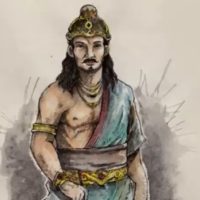Satrio Piningit : The Hidden Knight
Listen
At a glance
| Description | |
|---|---|
| Origin | Indonesian Mythology |
| Classification | Mortals |
| Family Members | N/A |
| Region | Indonesia |
| Associated With | Justice, Prophesy |
Satrio Piningit
Introduction
In the rich spiritual heritage of Javanese mythology, Satrio Piningit, meaning “Hidden Knight,” stands as one of the most anticipated prophetic figures. His story, originating from the Jongko Joyoboyo or Jayabaya Prophecies, describes a messianic leader destined to appear in an era of great chaos to restore justice, peace, and prosperity to Nusantara—the historical term for the Indonesian archipelago. The myth represents not only a foretelling of divine justice but also a profound reflection of the Javanese worldview, where balance between cosmic order and human virtue is paramount. Much like global messianic figures such as the Maitreya in Buddhism or the Imam Mahdi in Islam, Satrio Piningit embodies hope, renewal, and moral restoration during humanity’s darkest hours.
Across centuries, this prophecy has evolved beyond folklore into a living cultural motif, shaping Indonesia’s political imagination, spiritual movements, and expressions of collective hope. The figure of Satrio Piningit symbolizes a timeless desire for righteous leadership—someone who emerges from obscurity to challenge corruption, unify the people, and usher in a golden age of harmony.
Physical Traits
Descriptions of Satrio Piningit’s physical form are deeply symbolic, focusing on moral and spiritual essence rather than appearance. Ancient verses from the Jayabaya Prophecies describe him as humble, living in simplicity and poverty, his greatness hidden beneath an ordinary exterior. Unlike the radiant kings of legend, Satrio Piningit’s power lies in quiet strength and spiritual brilliance rather than in opulence or grandeur.
He is often said to resemble Batara Krishna, symbolizing divine charisma, and to possess the character of Baladewa, representing truth and unwavering loyalty. His countenance reflects compassion and resolve, while his demeanor remains unassuming—an indication of the Javanese ideal of nrimo (acceptance and humility). Some interpretations mention that his divine presence will be revealed through his aura and wisdom, rather than his lineage or physical majesty. Thus, his appearance bridges the divine and the human, showing that greatness can reside in the most humble of forms.
Family
The origins of Satrio Piningit are purposefully obscure, emphasizing his mysterious and divine nature. According to the prophecies, he is a descendant of the Majapahit royal line, connecting him to one of the most glorious empires in Indonesian history. This link situates him within the cultural and political lineage of Java’s golden age, reinforcing the idea that he carries forward the wisdom and authority of the past.
However, the prophecies also mention that he has “no father and aunt,” a poetic metaphor indicating his supernatural birth or spiritual conception. This detachment from ordinary familial structures highlights his divine mission rather than his bloodline. His life of solitude mirrors the archetype of the hidden savior, one who grows apart from worldly attachments to fulfill a greater destiny. Through this, Satrio Piningit becomes a symbol of both historical continuity and transcendence—a bridge between human lineage and divine will.
Other names
Over time, Satrio Piningit has been known by several names, each emphasizing different aspects of his identity and mission. The most prominent of these is Ratu Adil, meaning “King of Justice.” This title captures his ultimate role as a restorer of fairness, truth, and order in a morally decayed world. “Ratu” in Javanese culture refers to both a king and a spiritual sovereign, indicating not only political authority but also divine legitimacy.
Another title, Satrio Wiragung, translates to “The Great Ksatria,” portraying him as a noble warrior who endures suffering, humiliation, and hardship before rising to greatness. His journey from obscurity to enlightenment mirrors the Javanese concept of laku prihatin—the spiritual path of endurance and self-discipline that purifies one’s soul. Some versions also refer to him as Herucokro or Sang Penuntun (“The Guide”), names that emphasize his role as a moral and spiritual teacher destined to lead humanity through darkness toward enlightenment. Each name underscores a different facet of his divine duty—justice, courage, compassion, and transformation.
Powers and Abilities
Satrio Piningit’s abilities are portrayed as both supernatural and moral, reflecting his role as a divinely chosen leader. He is believed to possess clairvoyance and prophetic insight, granting him knowledge of the past, present, and future. This wisdom allows him to guide humanity away from destruction and toward harmony. His ability to control opposing forces—to bring unity where there is division—is one of his defining traits, symbolizing reconciliation in a fractured world.
In the Javanese mystical tradition, Satrio Piningit embodies the Hastabrata, eight divine virtues that align with elements of nature: the sun, moon, stars, earth, wind, fire, water, and ocean. Each element represents leadership qualities such as illumination, calmness, endurance, resilience, purity, and adaptability. These attributes portray him as an ideal ruler who governs with balance, compassion, and wisdom.
He is also said to wield a sacred weapon, Trisula Wedha, representing the spiritual force that ushers in a new age. This trident-like symbol is associated with transformation and divine justice, signaling the end of an era of oppression and the dawn of a new moral order. Yet, it is not raw power but his integrity and moral strength that truly define him, setting him apart as a leader guided by conscience rather than ambition.
Modern Day Influence
The legend of Satrio Piningit continues to shape modern Indonesian thought and identity. During the Japanese occupation (1942–1945), many Javanese believed the prophecy was fulfilled when “yellow men” drove out “white rulers,” interpreting the Japanese as the prophesied saviors. However, this belief faded as the occupation’s hardships unfolded, reaffirming that the true Satrio Piningit would arise from Java itself.
In the post-independence era, Sukarno, Indonesia’s first president, was often hailed by supporters as Satrio Piningit for his visionary leadership and anti-colonial struggle. Similar claims resurfaced with later leaders, including Joko Widodo (Jokowi), whose modest background and populist appeal led some to draw parallels with the prophecy. In each case, the myth serves as both political inspiration and a tool for legitimacy—an example of how ancient beliefs continue to influence modern governance and civic imagination.
Beyond politics, the myth permeates spiritual movements, particularly among Kejawen practitioners, who interpret Satrio Piningit as a symbol of inner awakening rather than a literal savior. In literature, theater, and film, he represents the archetypal hero who redeems society through moral integrity and self-sacrifice. Even in contemporary discourse on technology and power, Satrio Piningit’s story resurfaces as a metaphor for ethical leadership amid digital-era corruption and inequality.
Ultimately, the enduring myth of Satrio Piningit is more than a prophecy—it is a reflection of Indonesia’s collective soul. It embodies the timeless hope that in every era of crisis, a figure of justice and wisdom will emerge from among the people to guide them toward righteousness and renewal.
Related Images
Source
Harris, A. D. (2022, April 4). The Prophecy of Satrio Piningit. Retrieved from https://www.maitreya.org/english-newsbrief-2011-4-july-august-articles-prophecy-satrio-piningit
Satrio Piningit. (2010, December 29). Wikipedia. Retrieved from https://en.wikipedia.org/wiki/Satrio_Piningit
About: Satrio Piningit. (n.d.). DBpedia. Retrieved from https://dbpedia.org/page/Satrio_Piningit
Murti, G. A. (2025, July 9). The Satrio Piningit Complex & Technofeudalism: Indonesia’s Deeper Crisis. Whiteboard Journal. Retrieved from https://www.whiteboardjournal.com/column/the-satrio-piningit-complex-technofeudalism-indonesias-deeper-crisis/
Infopub: Satria Piningit: The Concept of Leadership Based on Javanese Local Wisdom. (2023, July 11). UIN Malang. Retrieved from https://ejournal.uin-malang.ac.id/index.php/infopub/article/view/20826
Anies Baswedan: in Search of Javanese Spiritually Qualified Satrio Piningit in Upholding Justice. (2023, April 19). KBA News. Retrieved from https://kbanews.com/pilihan-redaksi/anies-baswedan-in-search-of-javanese-spiritually-qualified-satrio-piningit-in-upholding-justice/
Satrio Piningit – Alchetron. (n.d.). Alchetron, The Free Social Encyclopedia. Retrieved from https://alchetron.com/Satrio-Piningit
Joyobhoyo, J. (n.d.). Jayabaya Prophecies (Jongko Joyobhoyo). Various Translations. Primary Source.
Ranggawarsita. (19th century). Serat Kalatidha. (Javanese prophetic poetry referencing Satrio Piningit).
Anderson, B. R. O. (1990). Language and Power: Exploring Political Cultures in Indonesia. Cornell University Press.
Geertz, C. (1960). The Religion of Java. University of Chicago Press.
Mulder, N. (1998). Mysticism in Java: Ideology in Indonesia. Penerbit Kanisius.
Frequently Asked Questions
What is lorem Ipsum?
I am text block. Click edit button to change this text. Lorem ipsum dolor sit amet, consectetur adipiscing elit. Ut elit tellus, luctus nec ullamcorper mattis, pulvinar dapibus leo.
What is lorem Ipsum?
I am text block. Click edit button to change this text. Lorem ipsum dolor sit amet, consectetur adipiscing elit. Ut elit tellus, luctus nec ullamcorper mattis, pulvinar dapibus leo.
What is lorem Ipsum?
I am text block. Click edit button to change this text. Lorem ipsum dolor sit amet, consectetur adipiscing elit. Ut elit tellus, luctus nec ullamcorper mattis, pulvinar dapibus leo.
What is lorem Ipsum?
I am text block. Click edit button to change this text. Lorem ipsum dolor sit amet, consectetur adipiscing elit. Ut elit tellus, luctus nec ullamcorper mattis, pulvinar dapibus leo.
What is lorem Ipsum?
I am text block. Click edit button to change this text. Lorem ipsum dolor sit amet, consectetur adipiscing elit. Ut elit tellus, luctus nec ullamcorper mattis, pulvinar dapibus leo.







